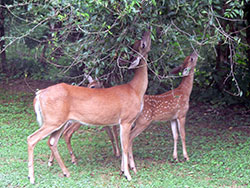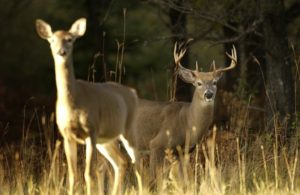Oh, Deer!
Creating a deer resistant garden involves understanding the animals’ habits.
By Thomas Christopher
The white-tailed deer is one of contemporary America’s great success stories. Its rock-bottom population went as low as ca. 1900, but it has since rebounded and in many areas, it is more abundant than it was when Europeans landed on these shores. In the meantime, its range has spread so that it now inhabits many areas where historically it wasn’t present before.
Its ally in this resurgence has been us. Deer love suburbs. Where human populations are thin such as in the northeast, so is the deer population. For example, in Massachusetts, state wildlife biologists estimate the deer population at only 10 to 15 individuals per square mile, whereas in the suburban eastern part of the state, the deer population frequently reaches 80 per square mile. There’s no hunting in the suburbs, and there’s plenty of the deer’s preferred diet: our garden plantings.
That’s why I’d call Ruth Rogers Clausen’s book, 50 Beautiful Deer-Resistant Plants, an essential gardening aid for our part of the country. Ruth, an English-trained horticulturist, was my first gardening mentor, head of the student program at the New York Botanical Garden when I enrolled, and co-author of the classic guide, Perennials for American Gardens (Random House, 1989). More recently, though, she has focused on what you can grow successfully in deer country.
This sprang from her years of experience gardening in a deer epicenter, Westchester County, New York. The expense of enclosing her entire yard with a deer-proof fence was prohibitive and anyway, she was reluctant to exclude the deer from a stream that was their customary watering hole. Likewise, she hated spraying with deer repellants and found that it was a never-ending chore, for the applications had to be repeated frequently throughout the growing season. It seemed far more practical to garden with plants that the deer did not like to eat.
Identifying such deer-resistant plants, Ruth says, depends largely on understanding the tastes of deer. Deer have sensitive noses, for example, and generally don’t favor aromatic herbs such as basil or the hybrid sages, or even strongly scented flowers. Nor do they like fuzzy or leathery foliage – the only rose they don’t routinely consume, for example, is the wrinkly-leaved rugosa rose and its hybrids, and they rarely molest the fuzzy dusty miller (Senecio cineraria) and licorice plant (Helichrysum petiolare). In addition, deer don’t favor plants with milky saps, such as members of the poppy family and euphorbias such as cushion spurge (Euphorbia polychroma).
Creating a deer resistant garden also involves understanding the animals’ habits. Ruth soon discovered, for example, that certain plants could be classified as “deer candy.” These include impatiens, tulips, daylilies, and hostas, which actually lured deer onto her property, making it one of their habitual dining areas. Once at home there, the deer also consumed plants that they might otherwise have left alone. Spring was a season of extra deer damage, in part because her plants’ new growth was soft and lush so that some plants such as astilbes that were unattractive to deer later in the growing season were more acceptable then. Spring also saw extra damage because new-born fauns would experiment with plants before deciding they were unpalatable.
One way to minimize deer damage, she discovered, was to grow the plants “lean;” that is, to keep fertilization and watering to a minimum. This made the plants less lush and so less attractive. Indeed, she learned that during a dry spell, if she watered in late afternoon she was practically guaranteed a visit from thirsty deer that night.
Having identified deer-resistant plants, Ruth rated them according to her own system, with a “1” signifying a very attractive plant such as a hosta, and a “9-10” indicating one that was almost never browsed, such as pachysandra. In her book, she has included only plants that earned a “7” or above. Among the most resistant, she found, are the ornamental grasses and ferns. With bulbs, she learned to avoid deer candy such as tulips and crocuses and instead rely on narcissus, alliums, snowdrops, leucojums and colchicums.
Just like our regional cuisines, deer’s tastes vary somewhat from region to region, and a plant that is deer-resistant in one area may be less so in another. Ruth encourages gardeners to compare her list of deer-resistant plants with those obtained from the local Cooperative Extension office. Still, I heartily recommend her book, 50 Beautiul Deer-Resistant Plants, for the insights it provides into the beauty and diversity a gardener may have, even in deer country.
Thomas Christopher is the co-author of “Garden Revolution” (Timber Press, 2016) and is a volunteer at Berkshire Botanical Garden. berkshirebotanical.org
Be-a-Better-Gardener is a community service of Berkshire Botanical Garden, one of the nation’s oldest botanical gardens in Stockbridge, MA. Its mission to provide knowledge of gardening and the environment through 25 display gardens and a diverse range of classes informs and inspires thousands of students and visitors on horticultural topics every year. Thomas Christopher is the co-author of Garden Revolution (Timber press, 2016) and is a volunteer at Berkshire Botanical Garden. berkshirebotanical.org.




